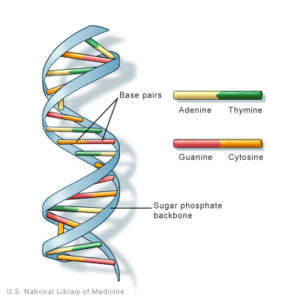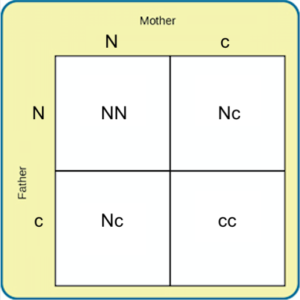What Do Male Sperm and Female Eggs Contribute to Offspring
Learning Outcomes
- Describe genetic components of conception
- Draw genes and their importance in genetic inheritance

Effigy ane. The Female Reproductive System.
Gametes
There are two types of sex cells or gametes involved in reproduction: the male gametes, or sperm, and female gametes, or ova. The male gametes are produced in the testes through a procedure called spermatogenesis, which begins at most 12 years of age. The female gametes, which are stored in the ovaries, are present at birth only are young. Each ovary contains about 250,000 ova but but about 400 of these volition become mature eggs (Mackon & Fauser, 2000; Rome, 1998). Beginning at puberty, one ovum ripens and is released about every 28 days, a procedure called oogenesis.
Later the ovum or egg ripens and is released from the ovary, it is drawn into the fallopian tube and in 3 to 4 days, reaches the uterus. It is typically fertilized in the fallopian tube and continues its journey to the uterus. At ejaculation, millions of sperm are released into the vagina, merely only a few reach the egg and typically, only 1 fertilizes the egg. Once a unmarried sperm has entered the wall of the egg, the wall becomes hard and prevents other sperm from entering. After the sperm has entered the egg, the tail of the sperm breaks off and the caput of the sperm, containing the genetic information from the father, unites with the nucleus of the egg. As a result, a new cell is formed. This cell, containing the combined genetic information from both parents, is referred to equally a zygote.
watch it
Watch as one single sperm survives the long and treacherous journey to fertilize the mother'due south egg.
You can view the transcript for "Fertilization" here (opens in new window).
Chromosomes
While other normal human cells have 46 chromosomes (or 23 pair), gametes comprise 23 chromosomes.Chromosomes are long threadlike structures found in a cell nucleus that contain genetic textile known asdeoxyribonucleic acid (Dna). DNA is a helix-shaped molecule fabricated up of nucleotide base of operations pairs [adenine (A), guanine (G), cytosine (C), and thymine (T)]. In each chromosome, sequences of Deoxyribonucleic acid make upgenes that control or partially control a number of visible characteristics, known as traits, such every bit heart color, pilus color, and so on. A single factor may have multiple possible variations or alleles. Anallele is a specific version of a gene. Then, a given factor may code for the trait of hair color, and the different alleles of that gene affect which hair color an individual has.

Figure 2. Deoxyribonucleic acid (DNA) is a helix-shaped molecule made upward of nucleotide base pairs. Sequences of DNA make up genes.
In a process chosen meiosis, segments of the chromosomes from each parent grade pairs and genetic segments are exchanged as determined past hazard. Because of the unpredictability of this commutation, the likelihood of having offspring that are genetically identical (and not twins) is ane in trillions (Gould & Keeton, 1997). Genetic variation is of import because it allows a species to adapt so that those who are better suited to the environs will survive and reproduce, which is an important factor in natural selection.
Genotypes and Phenotypes
When a sperm and egg fuse, their 23 chromosomes pair up and create a zygote with 23 pairs of chromosomes. Therefore, each parent contributes half the genetic information carried by the offspring; the resulting physical characteristics of the offspring (chosen the phenotype) are determined by the interaction of genetic cloth supplied by the parents (chosen the genotype). A person'sgenotype is the genetic makeup of that individual.Phenotype, on the other mitt, refers to the private's inherited physical characteristics.
Look in the mirror. What exercise you see, your genotype or your phenotype? What determines whether or not genes are expressed? Actually, this is quite complicated. Some features follow the condiment pattern which means that many unlike genes contribute to a final outcome. Height and peel tone are examples. In other cases, a gene might either be turned on or off depending on several factors, including the gene with which it is paired or the inherited epigenetic tags.
Spotter it
Watch the post-obit clip that explains meiosis.
You tin view the transcript for "MEIOSIS – Fabricated SUPER EASY – ANIMATION" here (opens in new window).
Link To learning
Visit the webpage "What are DNA and Genes?" from the University of Utah to better understand Dna and genes, then watch the video "What is Inheritance?" to learn how the genes from parents pass on genetic information to their children.
Determining the Sex of the Kid
Xx-two of those chromosomes from each parent are similar in length to a corresponding chromosome from the other parent. However, the remaining chromosome looks like an X or a Y. Half of the male person's sperm contain a Y chromosome and one-half incorporate an X. All of the ova contain 10 chromosomes. If the child receives the combination of XY, the child volition be genetically male. If information technology receives the 20 combination, the kid will be genetically female person.
Many potential parents accept a articulate preference for having a boy or a girl and would like to determine the sexual practice of the child. Through the years, a number of tips have been offered for the potential parents to maximize their chances for having either a son or daughter as they prefer. For example, it has been suggested that sperm which carry a Y chromosome are more fragile than those carrying an X. And then, if a couple desires a boy, they can take measures to maximize the chance that the Y sperm reaches the egg. This involves having intercourse 48 hours afterward ovulation, which helps the Y sperm have a shorter journey to reach the egg, douching to create a more alkali metal environment in the vagina, and having the female achieve orgasm commencement so that sperm are not pushed out of the vagina during orgasm. Today, even so, in that location is new technology bachelor that makes it possible to isolate sperm containing either an X or a Y, depending on the preference, and use that sperm to fertilize a female parent's egg.
Try It
Genetic Variation and Inheritance
Genetic variation, the genetic difference betwixt individuals, is what contributes to a species' adaptation to its environment. In humans, genetic variation begins with an egg, several million sperm, and fertilization. The egg and the sperm each contain 23 chromosomes, which brand up our genes. A unmarried cistron may have multiple possible variations or alleles (a specific version of a gene), resulting in a variety of combinations of inherited traits.
Genetic inheritance of traits for humans is based upon Gregor Mendel'southward model of inheritance. For genes on an autosome (whatsoever chromosome other than a sexual activity chromosome), the alleles and their associated traits are autosomal dominant or autosomal recessive. In this model, some genes are considered ascendant because they volition be expressed. Others, termed recessive, are only expressed in the absenteeism of a dominant factor. Some characteristics which were once thought of as dominant-recessive, such equally middle color, are now believed to exist a result of the interaction betwixt several genes (McKusick, 1998). Ascendant traits include curly pilus, facial dimples, normal vision, and dark hair. Recessive characteristics include red hair, pattern baldness, and nearsightedness.
Sickle prison cell anemia is an autosomal recessive disease; Huntington disease is an autosomal dominant affliction. Other traits are a result of fractional authorization or co-say-so in which both genes are influential. For example, if a person inherits both recessive genes for cystic fibrosis, the disease will occur. Simply if a person has only one recessive factor for the affliction, the person would be a carrier of the disease.
In this example, we will call the normal gene "N," and the gene for cystic fibrosis "c." The normal gene is ascendant, which means that having the dominant allele either from one parent (Nc) or both parents (NN) will e'er result in the phenotype associated with the dominant allele. When someone has two copies of the same allele, they are said to behomozygous for that allele. When someone has a combination of alleles for a given gene, they are said to beheterozygous. For example, cystic fibrosis is a recessive disease which means that an individual will but have the illness if they are homozygous for that recessive allele (cc).
Imagine that a woman who is a carrier of the cystic fibrosis gene has a kid with a man who besides is a carrier of the same affliction. What are the odds that their child would inherit the disease? Both the adult female and the man are heterozygous for this gene (Nc). We tin can expect the offspring to have a 25% chance of having cystic fibrosis (cc), a fifty% chance of being a carrier of the affliction (Nc), and a 25% take a chance of receiving two normal copies of the gene (NN).

Effigy 3. A Punnett square is a tool used to predict how genes will interact in the product of offspring. The majuscule N represents the ascendant allele, and the lowercase c represents the recessive allele. In the example of the cystic fibrosis, where N is the normal factor (dominant allele), wherever a pair contains the ascendant allele, Northward, y'all can look a phenotype that does not express the disease. Yous can expect a cystic fibrosis phenotype just when there are 2 copies of the c (recessive allele) which contains the cistron mutation that causes the affliction.
Where do harmful genes that contribute to diseases similar cystic fibrosis come from? Gene mutations provide one source of harmful genes. Amutation is a sudden, permanent alter in a factor. While many mutations can be harmful or lethal, once in a while a mutation benefits an individual past giving that person an advantage over those who do not take the mutation. Recollect that the theory of evolution asserts that individuals best adapted to their particular environments are more probable to reproduce and pass on their genes to future generations. In club for this process to occur, there must be competition—more than technically, there must exist variability in genes (and resultant traits) that allow for variation in adjustability to the surround. If a population consisted of identical individuals, then whatever dramatic changes in the environs would affect everyone in the aforementioned way, and there would be no variation in selection. In contrast, variety in genes and associated traits allows some individuals to perform slightly improve than others when faced with ecology alter. This creates a distinct advantage for individuals best suited for their environments in terms of successful reproduction and genetic transmission.
Watch Information technology
This video demonstrates some other example of the interaction of alleles using the Punnett square.
You can view the transcript for "An Introduction to Mendelian Genetics | Biomolecules | MCAT | Khan Academy" here (opens in new window).
Try It
Glossary
- allele:
- a specific version of a factor
- chromosome:
- a DNA molecule with part or all of the genetic material of an organism
- deoxyribonucleic acrid (DNA):
- a helix-shaped molecule made upwardly of nucleotide base pairs
- gamete:
- a male or female person reproductive prison cell
- genes:
- sequences of Deoxyribonucleic acid that command or partially command a number of characteristics
- genotype:
- the genetic makeup of an individual
- heterozygous:
- a combination of alleles for a given gene
- homozygous:
- having 2 copies of the same allele for a given factor
- mutation:
- a sudden permanent alter in a gene
- phenotype:
- the individual'southward inherited concrete characteristics
Contribute!
Did you lot have an thought for improving this content? Nosotros'd honey your input.
Improve this pageLearn More
Source: https://courses.lumenlearning.com/wm-lifespandevelopment/chapter/heredity-and-chromosomes/